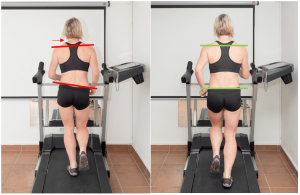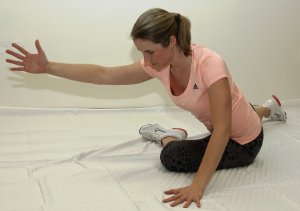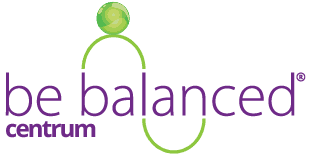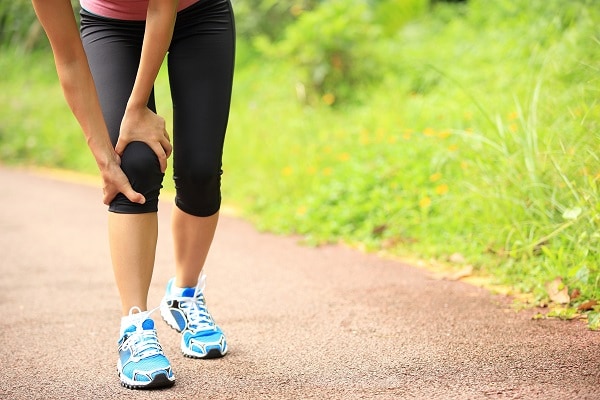Trápí vás bolesti kolen při běhu?
Bolesti kolen jsou jedny z nejčastějších potíží běžců. Objevují se jak u začátečníků, tak u pokročilých a často se opakovaně vrací. Bývají spojeny s úrazem, navýšením tréninkových objemů či intenzit nebo nedostatečnou regenerací. Někdy ale koleno začne bolet z ničeho nic, jakoby bez příčiny. Důvodem může být přetížení, ale ne to nadměrným objemem zátěže. Máme na mysli přetížení dané neoptimální polohou kloubu, tedy jeho nerovnoměrným zatížením. Objektivně máte třeba jen malou pohybovou zátěž, ale i přesto si přetížení vytvoříte, protože některé struktury jsou zatěžovány více a jiné zase méně. Obvykle volíme pauzu v tréninku na dva týdny až měsíc a po opětovném zatížení jsou bolesti po pár sebězích z kopce zpět v úplně stejné míře.
Pojďme se podívat na nejčastější zranění a jejich příčiny:
Běžecké koleno – patellofemorální syndrom – jedná se o přetížení chrupavky pod čéškou. Častěji se vyskytuje u žen a u začínajících běžců. Projevuje se bolestmi zepředu na koleni, okolo a pod čéškou. Tento syndrom se vyvíjí dlouho. Většinou se nejedná o akutní poranění (to jen v případě, že na koleno spadnete), ale o dlouhodobé nevhodné přetěžování. Bolesti se objevují typicky s chůzí po schodech a z kopce. Pro zmírnění potíží se vyplatí protahovat přední stranu stehen. Zkrácený stehenní sval působí neustálý tlak na čéšku a tím trvale stlačuje i chrupavku. Dále pomůže dočasné omezení objemů a vynechání kopců. Regenerovat chrupavku může i kloubní výživa s obsahem glukosamin sulfátu. Tejpování kolene pro podporu čéšky se koleno odlehčí.
ITBS – syndrom iliotibiálního traktu – cítíme-li bolest na zevní straně kolene zvláště při chůzi ze schodů, či z kopce a při ohnutí kolene více než 30 stupňů, pravděpodobně se potýkáme s ilitobiálním syndromem. Jedná se o bolest úponu staženého vazivového pruhu na zevní straně stehna. Do tohoto vazivového pruhu nahoře na zevní straně pánve vzařuje sval, který pomáhá bočně stabilizovat pánev. Tento sval ovšem kvůli nesprávnému postavení pánve pracuje výrazně více, než by měl. Tedy hodně tahá za svůj úpon na zevní straně kolene. Při ohnutí kolene se napnutý úpon dře o kostěné nerovnosti na zevní straně kolene a s větším drážděním se míra přetížení a poranění zvětšuje. Vzniká sterilní zánět. Tuto bolest tedy rozhodně nejde přeběhat. Pomoci si můžeme jednak uvolněním boční strany stehna, tedy mechanickým rozpracováním na zevní straně stehna třeba na pěnovém válci nebo kuchyňském válečku. Může pomoci i tejpování a protahování. To ovšem neřeší příčinu problému a tak nemusí být řešením trvalým. Je nutné ovlivnit správné postavení pánve a zapojení svalů na zevní straně kyčle ve stojné fázi nohy.
Skokanské koleno – patellární tendinitis – projevuje se bolestí při dolním okraji čéšky a na výběžku na holenní kosti pod čéškou. Jedná se o přetížení čtyřhlavého svalu stehenního v místě úponu jeho šlachy k holenní kosti. K přetížení dochází při výskoku a doskoku, kdy se koleno a s ním i šlacha předního stehenního svalu natahuje. Tímto mechanismem se při svalové nerovnováze úpon při dolním okraji čéšky přetěžuje. Objevuje se hlavně u volejbalistů, basketbalistů a obecně všech atletů. U běžců tak časté není. Pokud tyto potíže máte i jako běžec, znamená to, že při běhu hodně skáčete, máte zkrácený přední stehenní sval, v běhu sedíte a noha málo pruží. V počátku je účinné bolestivé místo ledovat a tejpovat jako při patellofemorálním syndromu.
Poškození chrupavky na kloubních plochách kolene – k těmto potížím řadíme veškerá poškození chrupavky v oblasti kolene. Projeví se pocity píchání v okolí kloubu a náhlého podlomení nohy. Jedná se o změny hlubokých vrstev chrupavky, které se dalším nesprávným zatěžováním rozšíří blíže k povrchu. Dochází k nim při nadměrném zatěžování kloubů – prudké nárazy, dopady, nesprávný došlap, špatná ekonomika běhu.
Poškození menisků – meniskus se nejčastěji poškodí po nárazu, podvrtnutí kloubu, prudkým otočením kolena do strany. Může se ale poškodit postupně vytrvalým nevhodným zatížením. Projeví se bolestí v kloubní štěrbině na straně poškozeného menisku. Kolena bolí hlavně po zátěži. Nejčastěji je poraněn vnitřní meniskus. V tom případě vám vadí turecký sed a sed na patách. Je potřeba koleno nedráždit, tím se poranění zvětšuje. Tedy nedělat to, co bolí.
Podívejme se na koleno trochu komplexněji.
Koleno je středový kloub mezi chodidlem a kyčlí. Noha má spojení se zemí. Kyčel je zase spojená s pánví a ta zase se zemí. Zatímco koleno nemá blízko k žádnému pevnému bodu, je ponecháno uprostřed napospas svým stabilnějším sousedům. Je tak trochu otrokem toho, jak bude postavená noha a kyčel. Proto když bolí koleno, nemůže za to samotné koleno, ale ti, kteří jsou zodpovědní za jeho polohu, tedy noha, kyčel a pánev. Z toho vyplývá i léčba. Není možné koleno vyléčit kroužením ultrazvukové hlavice kolem bolestivého místa či posilováním třeba předního stehenního svalu. Je potřeba zajistit, aby kosti, které se v koleni stýkají, měly správný směr a správně byli v pohybu sladěné.

Problém chůze a běhu
Při chůzi a běhu se musíme popasovat se situací, kterou naši čtyřnozí kolegové neznají. A to s fází, kdy stojíme na jedné noze. Ve stoji jsme stabilní. Máme váhu na obou nohách, tedy váha trupu a pánve je dobře rozdělená, těžnice padá mezi naše chodidla. Co se stane, když ubereme jednu nohu, tedy jeden bod opory? Musíme se nad jednou nohou nějak vybalancovat. Buď se nad jednou nohou dokážeme dobře napřímit, nebo, a to je častější, zvolíme nějaký jednodušší náhradní mechanizmus. Třeba že se zavěsíme do stojné kyčle a vysuneme ji do strany, nebo se nad nohu celí ukloníme. A to se pak děje při každém kroku.
Většinou máme stranový rozdíl, kdy jedna kyčel nás drží lépe než druhá. Proto se tedy dříve ozve problém na jedné straně. Pokud máme problém na obou stranách, mohou bolet obě kolena stejně.
Proto je bolest kolen tak častá. K tomu můžeme přičíst prodlužující se délku života a překyselující stravu dnešní doby, která chrupavkám neprospívá.
Možnými příčinami všech výše popsaných poškození kolenního kloubu jsou:
• Noha – nesprávné postavení nohy při došlapu, nedostatečná aktivace svalů plosky
• Kyčle – nesprávná stabilizace kyčelních kloubů z boku
• Trup a pánev – vysazená pánev, špatné zapojení svalů trupu, asymetrie v trupu vedoucí k úklonu do jedné strany
Noha
Při běhání je velmi důležité používat celou plosku nohy pro odraz a dopad. Běžci často zapomínají na prsty nohou, které nám mohou velmi pomoct při zlepšení efektivity odrazu a dopadu. Svaly plosky nohy mají obrovský potenciál. V běžném dni, kdy nosíme neustále boty, prsty vůbec nepoužíváme. Je to jako bychom měli celé dny na rukou tlusté rukavice bez rozdělení prstů. Ruce by také postupně odvykaly jemné manuální práci. S nohou se to má stejně. Při běhu se snažte prsty uchopovat zem. Myslete na všechny prsty, tedy i malíčky uchopujete zem. To může pomoci omezit propadání kotníku dovnitř, tedy nadměrné pronaci.
Kyčle
Při správném zapojení svalů okolo kyčelního kloubu, zlepšení stability kyčle a pánve při běhání se koleno může v opoře udržet ve správné pozici, tedy nepáčí se do stran, nejčastěji dovnitř. Pokud chceme zlepšit práci těchto svalů, nepomůže nám cvičení typu unožování nohy do strany ve stoji, nebo lehu, ale cvičení, kde jsme nuceni se o kyčelní kloub opřít. Tak trénujeme původní funkci kyčelních kloubů, tedy nosnou funkci kyčle, aniž bychom přetěžovali svaly, které v pro tuto funkci nepotřebujeme.
Vyzkoušejte si cvičení pro dobré vzpřímení na kyčli: Z polohy na čtyřech vysuňte jedno koleno dopředu mezi dlaně, sedněte si na bok. Ruce posuňte kousek dopředu, aby byly tak 20cm před kolenem. Měli byste cítit protažení na zevní straně kyčle (přes zadek). Protažení samo o sobě nestačí, sval je potřeba v tomto protažení intenzivně zapojit. Proto nadzvedněte opačnou ruku, jako kdybyste se chtěli za něčím vytáhnout. V tu chvíli byste měli cítit, že se sval zapojil, tedy že stehno se intenzivně opírá o zem a svaly kolem kyčle musí hodně pracovat. Pokud tuto práci necítíte, děláte něco špatně. Buď máte moc váhu na druhé ruce, je potřeba se vytáhnout za zvednutou rukou, nebo máte svaly kyčle tak vypadlé, že se neumí automaticky zapojit. V tom případě aktivně zatlačte kolenem dolů do země, jako byste se chtěli na koleni zvednout.

Trup a pánev
Nadměrné rotace pánví a/nebo její posun ze strany na stranu jsou pro běh velmi neekonomické. Příčinou toho je špatná práce hlubokých svalů trupu, které nepodrží dostatečně hrudník s pánví spojený. Tímto akorát dochází k přetěžování zad. Během běhu je dobré se soustředit na vytažení se vzhůru jako bychom něco nesli na hlavě, tím přestaneme skákat a v běhu se lépe napřímíme. Dále je účinné srovnat práci paží, tak aby se pohybovaly předozadně, tedy ne do stran. Pohyb paží pomůže zpevnit trup.

